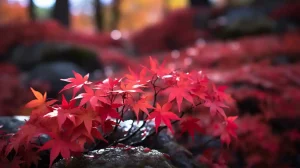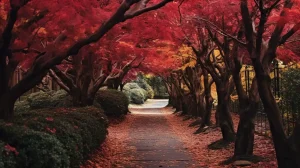
The Essence of Japanese Maples: Beauty, Grace, and Serenity
While the Japanese maple’s exquisite fall color might be their most celebrated feature, their charm extends far beyond a single season. As spring awakens, these trees unfurl a fresh tapestry of delicate, lacy leaves that shimmer in the soft light, creating an ethereal backdrop for the garden. In the summer, the foliage deepens in color, casting dappled shadows that offer a cool, peaceful retreat from the heat of the day.
As the years pass, the Japanese maple continues to enchant, its branches twisting and contorting into a sculpture-like form that reflects the passage of time. As a testament to their resilience, these trees can live for over a century, their gnarled trunks and limbs telling a story of perseverance and grace, inspiring generations of gardeners to appreciate the quiet beauty that lies within the natural world.
Nature’s Masterpiece: A Tapestry of Color
If there’s one thing that truly encapsulates the wonder of Japanese maples (Acer palmatum), it’s their phenomenal fall colors. As the seasons change, these elegant trees transform into living art, their foliage bursting into vibrant shades of reds, purples, and fiery oranges. It’s a breathtaking sight that never fails to stir the soul and remind us of the beauty that lies within the natural world.
A Symbol of Timelessness and Elegance
Japanese maples are more than just trees; they are symbols of timelessness and elegance. With their delicate, lacy leaves and gracefully arching branches, these enchanting trees exude a sense of serenity and refinement that can transport us to a world of tranquility and calm. As a gardener, I’m continually captivated by the quiet grace of these trees and the unique character they bring to my outdoor haven.
The Many Faces of Japanese Maples: Foliage, Form, and Variety
In my journey through the world of Japanese maples, I’ve discovered a diverse array of foliage colors, tree forms, and varieties. From the striking purples and reds of the classic ‘Bloodgood’ to the subtle variegation of the ‘Butterfly,’ each cultivar offers its own distinct charm and personality, allowing us to create a garden that reflects our own unique vision and spirit.
The Art and Science of Japanese Maple Care: A Gardener’s Labor of Love

Beyond their basic requirements, Japanese maples also benefit from a little extra attention to ensure they remain healthy and vibrant. A well-balanced, slow-release fertilizer applied in the spring can provide essential nutrients that support growth and foliage color. Additionally, it’s important to monitor the tree for any signs of pests or diseases, addressing any issues early on to prevent further damage and maintain the tree’s vitality.
When it comes to transplanting or moving a Japanese maple, timing and care are crucial. The best time for this task is during the tree’s dormancy, typically in late fall or early spring. By carefully digging around the root ball, ensuring minimal root disturbance, and replanting the tree in a suitable location, we can give our Japanese maples the best chance to establish themselves and thrive in their new surroundings.
The Perfect Home: Location, Soil, and Water
Like all living things, Japanese maples require the right environment to thrive. Their ideal location is protected from harsh winds and spring frosts, offering them a gentle refuge from the elements. These trees also prefer moist, well-drained, slightly acidic soil—a foundation that supports their health and growth. Lastly, regular watering and a layer of mulch help maintain the perfect balance of moisture and nutrients, ensuring that our beloved trees flourish in their new homes.
The Delicate Dance of Pruning: Balance, Beauty, and Growth
One of the most rewarding aspects of Japanese maple care is the art of pruning. With careful attention and a keen eye, we can thin out branches and enhance the tree’s natural form, ensuring that it maintains its beauty and elegance throughout the years. This process is more than just a chore; it’s a delicate dance between ourselves and nature, a testament to our imperfections as we strive to achieve harmony within our gardens.
The Art of Container Planting: Small Wonders and Endless Possibilities
For those with limited space, container planting offers a world of opportunity. Small varieties and dwarf forms of Japanese maples are perfectly suited to this gardening solution, allowing us to enjoy the charm and grace of these trees even in the most compact of spaces. By carefully selecting the right tree and container, we can create a living sculpture that brings color, texture, and tranquility to any corner of our outdoor sanctuaries.
The Garden’s Symphony: Japanese Maples and Their Companion Plants
In addition to ginkgos, rhododendrons, and conifers, there are many other companion plants that can beautifully complement the Japanese maple. Understory plants like ferns and hostas can provide interesting textures and shapes that contrast with the delicate leaves of the maple, while perennials like astilbes, heucheras, and hellebores can offer pops of color that harmonize with the tree’s vibrant hues.
Moreover, don’t be afraid to experiment with combinations and arrangements, as the possibilities are endless. Consider the Japanese maple growing zone, as well as the needs and habits of each companion plant, to create a garden that is both visually stunning and ecologically balanced. By thoughtfully curating the plant palette and carefully considering the interplay of colors, textures, and forms, we can transform our gardens into a living tapestry that delights the senses and nourishes the soul.
A Harmonious Ensemble: Ginkgos, Rhododendrons, and Conifers
Japanese maples not only stand out as singular specimens, but they also play a vital role in the garden’s orchestra of plants. Their delicate foliage and elegant form provide the perfect contrast to the more robust and bold textures of ginkgos, rhododendrons, and conifers. Together, these plants form a harmonious ensemble, each contributing its own unique voice to the symphony of the garden.
The Dance of Light and Shadow: Complementing Foliage Colors
The key to creating a visually stunning garden lies in the interplay of light and shadow, as well as the harmony of foliage colors. Pairing Japanese maples with plants that feature contrasting foliage colors can create a stunning visual impact. For instance, combining a red-leafed maple with a lime-green or golden-leaved companion plant can create a dazzling display that captures the eye and elevates the garden’s overall aesthetic.
Zones and Adaptability: Ensuring Success in Your Garden
Japanese maples are generally suited for zones 5-8, but it’s essential to consider the specific heat and frost tolerance of each cultivar when selecting the perfect tree for your garden. By taking these factors into account and ensuring that our trees are well-protected from extreme temperatures, we can foster their success and enjoy their enchanting beauty for many years to come.
Transplanting japanese maple
Transplanting a Japanese maple requires careful planning and execution to ensure its successful establishment in a new location. Follow these steps for a smooth transition:
- Timing: The ideal time for transplanting a Japanese maple is during its dormancy, typically in late fall or early spring, when the tree is not actively growing.
- Site selection: Choose a suitable location that offers protection from harsh winds and spring frosts. The site should have moist, well-drained, slightly acidic soil, and receive dappled sunlight or partial shade.
- Preparation: Water the tree deeply a day or two before transplanting to reduce stress and help retain the root ball’s integrity.
- Digging: Carefully dig around the tree’s root ball with a sharp spade, maintaining a distance of about 12 inches from the trunk for a small tree, and up to 24 inches for larger specimens. Dig deep enough to preserve as many roots as possible.
- Root ball: Gently lift the root ball from the ground, taking care not to damage the roots. You may need assistance for larger trees. If the root ball is too large, wrap it in burlap to keep it intact during transport.
- Planting hole: Dig a hole in the new location that is twice as wide and as deep as the root ball. Amend the soil with organic matter if necessary to improve drainage and acidity.
- Planting: Place the tree in the hole, ensuring that the top of the root ball is level with the surrounding soil. Fill the hole with soil, gently firming it around the roots to eliminate air pockets.
- Watering: Water the tree thoroughly after transplanting to help settle the soil and establish good contact between the roots and their new environment.
- Mulching: Apply a 2-3 inch layer of organic mulch around the base of the tree, keeping it a few inches away from the trunk. Mulch helps retain moisture, regulate soil temperature, and suppress weeds.
- Aftercare: Monitor the tree for signs of stress, such as wilting or yellowing leaves, and provide regular watering during the first growing season to support its establishment. You may also consider staking the tree if it’s in a particularly windy area.
By following these guidelines, you can give your Japanese maple the best chance to thrive in its new home.
Final Thoughts: The Enduring Allure of Japanese Maples

In a world that can often feel chaotic and disconnected, the timeless elegance and beauty of Japanese maples serve as a gentle reminder of the tranquility and harmony that can be found within nature. As we tend to our gardens—pruning, watering, and nurturing our cherished trees—we not only create a haven of serenity for ourselves but also forge a deeper connection with the natural world that surrounds us.
So, as you embark on your journey into the enchanting universe of Japanese maples, may you find inspiration, peace, and a renewed sense of wonder in the artistry of nature. Happy gardening!

What a beautifully written ode to the enchanting world of Japanese maples! Their timeless elegance and vibrant colors truly make them stand out in any garden. As you embark on your journey with these trees, here’s an additional tip: Consider adding a layer of organic mulch not only around the base but also within the tree’s drip line. This will help conserve moisture, protect the shallow roots, and enhance the overall health of your Japanese maples. Happy gardening, and may your outdoor sanctuary flourish with the grace of these remarkable trees!
Thanks,
Al Gardener